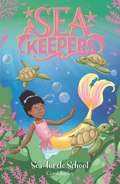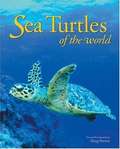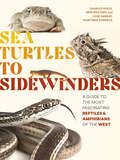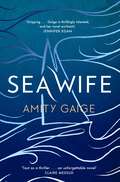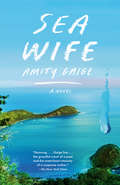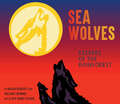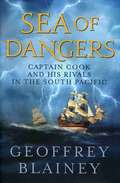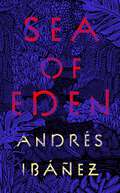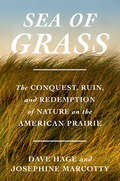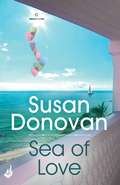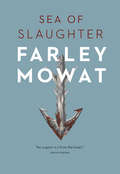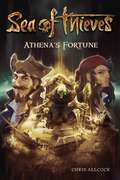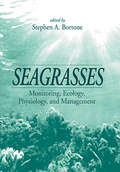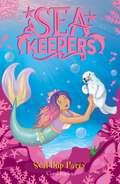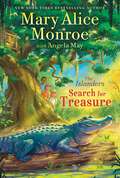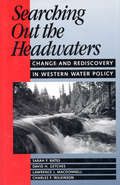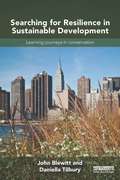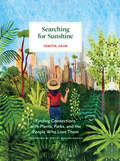- Table View
- List View
Sea Turtle School: Book 4 (Sea Keepers #4)
by Coral RipleyTime for school! The Sea Keepers attend a very special underwater school in this magical new series about saving our oceans.It's time for baby sea turtles to be born, but the beach is covered in rubbish! The Sea Keepers need to clean up the sand before the eggs hatch. But not everyone wants to help the baby sea turtles . . . Evil siren Effluvia has sent vicious ghost crabs to gobble them up! Can Emily, Grace and Layla find a magic pearl to get the hatchlings safely to Sea Turtle School? Or will Effluvia beat them to it?
Sea Turtles
by Gail Gibbons<p>Dive into the world's oceans to explore the dangerous lives of one of the oldest living animals. <p>Descended from enormous prehistoric creatures, sea turtles are fascinating. Hatched from eggs smaller than a baseball, some can grow to weigh over a thousand pounds. Once adults, they can live to be around 100 years old. And when it's time to nest, they migrate more than 1,000 miles. <p>With colorful, clear illustrations and straightforward text, Gail Gibbons introduces the eight kinds of sea turtles living in the ocean today. Learn the similarities and differences with labeled diagrams and experience the hatching of the tiny turtle babies with detailed illustrations. This updated edition now includes the most up-to-date information about these beloved reptiles, as reviewed by an expert vetter in the field of herpetology. <p>Sea Turtles also gives young readers an accessible overview of how the lives of these large reptiles have become threatened and discusses the conservation efforts currently taking place. Ideal for aspiring oceanographers, this brightly-illustrated book is a perfect introduction to the subject.</p>
Sea Turtles of the World (World Life Library)
by Jeff RippleMillions of sea turtles once roamed the earth’s oceans. Within the past five centuries, trade in sea turtle meat, eggs, shells, oil, and leather has driven almost every species to the brink of extinction. Explore the world of the sea turtle in this engaging book. Learn their general characteristics, how they navigate underwater, who their predators are, what human threats exist, and where conservation efforts are being made worldwide. Jeff Ripple profiles every species of sea turtle from the loggerhead to the leatherback. More than 60 breath-taking photographs capture these fascinating creatures underwater and on land.
Sea Turtles to Sidewinders: A Guide to the Most Fascinating Reptiles and Amphibians of the West
by Charles Hood Erin Westeen Jose Gabriel Martinez-Fonseca"For families wanting to explore their local wildlife as well as an engaging read for those with a general interest in the subject.&” —Booklist The American West is home to a wide array of reptiles and amphibians-from the rare and curious to those that can be found in parks and backyards. With this user-friendly guide in hand, discover the most likely-to-be-encountered lizards, snakes, turtles, and amphibians native to Arizona, California, Idaho, Nevada, Oregon, Utah, and Washington, plus the western parts of Montana, Wyoming, Colorado, and New Mexico. Whether you are a dedicated herper or simply have a keen interest in wildlife and natural history, Sea Turtles to Sidewinders—from Charles Hood, Erin Westeen, and Jose Gabriel Martfnez-Fonsec—will help you appreciate and celebrate the amazing diversity represented by reptiles and amphibians of the West.
Sea Wife
by Amity Gaige'Taut as a thriller' Claire Messud 'A gripping tale of survival at sea - but that's just the beginning' Jennifer Egan'A smart, swift and thrilling novel' Lauren GroffFrom the highly acclaimed author of Schroder, a smart, sophisticated literary page turner about a young family who escape suburbia for a year-long sailing trip that upends all of their livesJuliet is failing to juggle motherhood and her anemic dissertation when her husband, Michael, informs her that he wants to leave his job and buy a sailboat. The couple are novice sailors, but Michael persuades Juliet to say yes. With their two kids - Sybil, age seven, and George, age two, Juliet and Michael set off for Panama, where their forty-four-foot sailboat awaits them - a boat that Michael has christened the Juliet.The initial result is transformative: their marriage is given a gust of energy, and even the children are affected by the beauty and wonderful vertigo of travel. The sea challenges them all - and most of all, Juliet, who suffers from postpartum depression.Sea Wife is told in gripping dual perspectives: Juliet's first-person narration, after the journey, as she struggles to come to terms with the dire, life-changing events that unfolded at sea; and Michael's captain's log - that provides a riveting, slow-motion account of those same inexorable events.Exuberant, harrowing, witty and exquisitely written, Sea Wife is impossible to put down.
Sea Wife: A novel
by Amity Gaige"Sea Wife is a gripping tale of survival at sea—but that&’s just the beginning. Amity Gaige also manages, before she&’s done, to probe the underpinnings of romantic love, marriage, literary ambition, political inclinations in the Trump age, parenthood, and finally, the nature of survival itself in our broken world. Gaige is thrillingly talented, and her novel enchants."—Jennifer Egan&“Sea Wife brilliantly breathes life not only into the perils of living at sea, but also into the fraught and hidden dangers of domesticity, motherhood, and marriage. What a smart, swift, and thrilling novel.&”—Lauren GroffFrom the highly acclaimed author of Schroder, a smart, sophisticated page literary page-turner about a young family who escape suburbia for a yearlong sailing trip that upends all of their lives.Juliet is failing to juggle motherhood and her stalled-out dissertation on confessional poetry when her husband, Michael, informs her that he wants to leave his job and buy a sailboat. With their two kids—Sybil, age seven, and George, age two—Juliet and Michael set off for Panama, where their forty-four foot sailboat awaits them. The initial result is transformative; the marriage is given a gust of energy, Juliet emerges from her depression, and the children quickly embrace the joys of being feral children at sea. Despite the stresses of being novice sailors, the family learns to crew the boat together on the ever-changing sea. The vast horizons and isolated islands offer Juliet and Michael reprieve – until they are tested by the unforeseen. Sea Wife is told in gripping dual perspectives: Juliet&’s first person narration, after the journey, as she struggles to come to terms with the life-changing events that unfolded at sea, and Michael&’s captain&’s log, which provides a riveting, slow-motion account of these same inexorable events, a dialogue that reveals the fault lines created by personal history and political divisions. Sea Wife is a transporting novel about marriage, family and love in a time of unprecedented turmoil. It is unforgettable in its power and astonishingly perceptive in its portrayal of optimism, disillusionment, and survival.
Sea Wolves: Keepers of the Rainforest
by Melanie Crowder MEGAN BENEDICTThis lyrical, stunningly illustrated book explores the sea wolf—an apex marine mammal evolved from the gray wolf—as it navigates the coastline, eats seafood, and lives its extraordinary, unusual life.Sea Wolves: Keepers of the Rainforest is the astonishing story of a wolf species that calls the shores of western Canada and southeastern Alaska home. Here, wolves crack clams, feast on fish roe, swipe salmon from rivers, and swim miles between islands—as long observed by the First Nations communities that have lived alongside them for thousands of years. However, with the rise of industrial logging, pipeline projects, and other threats, sea wolves face a troubled future. Wildlife experts and First Nations members agree: these majestic creatures are a vital part of the ecosystem and need to be protected.Through beautiful verse and striking illustrations, Sea Wolves captures the fascinating life of an animal with great cultural and scientific significance—one that will inspire awe in young readers.
Sea of Dangers: Captain Cook and His Rivals in the South Pacific
by Geoffrey BlaineyIn 1769 two ships set out independently in search of a missing continent: a French merchant ship, the St. Jean-Baptiste, commanded by Jean de Surville, and a small British naval vessel, the Endeavour, commanded by Captain James Cook. That Christmas, in New Zealand waters, the two captains were almost within sight of each other, though neither knew of the other's existence. This is the stirring tale of these rival ships and the men who sailed in them.
Sea of Eden
by Andrés IbáñezWINNER OF SPAIN'S NATIONAL CRITICS AWARD The epic literary adventure that has transfixed readers and critics alike in Spain Almost four hundred passengers are on board the Boeing 747 en route from Los Angeles to Singapore. Only a handful will survive the crash. Washed ashore on a tiny island with no means of contacting the outside world, tension and fear threaten to overwhelm the group. But as they endeavour, day by day, to survive, they find themselves forced to confront the reality of the lives they left behind. Written in deftly cinematic prose, Andrés Ibáñez&’s stunning novel is already considered a modern classic in Spain, expertly translated here by Sophie Hughes. 'Ibáñez is, quite simply, a genius' La Vanguardia
Sea of Grass: The Conquest, Ruin, and Redemption of Nature on the American Prairie
by Dave Hage Josephine MarcottyA vivid portrait of the American prairie, which rivals the rainforest in its biological diversity and, with little notice, is disappearing even faster&“This book describes—in loving, living prose—one of the world&’s greatest and most important landscapes. And it does so while there&’s still time to save some serious part of it.&”—Bill McKibben, author of The End of NatureThe North American prairie is an ecological marvel, a lush carpet of grass that stretches to the horizon, and home to some of the nation&’s most iconic creatures—bison, elk, wolves, pronghorn, prairie dogs, and bald eagles. Plants, microbes, and animals together made the grasslands one of the richest ecosystems on Earth and a massive carbon sink, but the constant expansion of agriculture threatens what remains.When European settlers encountered the prairie nearly two hundred years ago, rather than a natural wonder they saw an alien and forbidding place. But with the steel plow, artificial drainage, and fertilizers, they converted the prairie into some of the world&’s most productive farmland—a transformation unprecedented in human history. American farmers fed the industrial revolution and made North America a global breadbasket, but at a terrible cost: the forced dislocation of Indigenous peoples, pollution of great rivers, and catastrophic loss of wildlife. Today, industrial agriculture continues its assault on the prairie, plowing up one million acres of grassland a year. Farmers can protect this extraordinary landscape, but trying new ideas can mean ruin in a business with razor-thin margins, and will require help from Washington, D.C., and from consumers.Veteran journalists and midwesterners Dave Hage and Josephine Marcotty reveal humanity&’s relationship with this incredible land, offering a deep, compassionate analysis of the difficult decisions as well as opportunities facing agricultural and Indigenous communities. Sea of Grass is a vivid portrait of a miraculous ecosystem that makes clear why the future of this region is of essential concern far beyond the heartland.
Sea of Love: Bayberry Island Book 1 (Bayberry Island)
by Susan DonovanNew York Times bestselling author Susan Donovan welcomes you to Bayberry Island, a special place where a bronze mermaid statue promises to grant true love to anyone who asks with an open heart... Perfect for fans of Susan Elizabeth Phillips, JoAnn Ross and Jill Shalvis.Rowan Flynn was happy to leave Bayberry Island when she was whisked away by her investor fiancé. But when he loses what's left of her family's fortune and is exposed as a con man, Rowan reluctantly returns to run the Safe Haven Bed and Breakfast, determined never again to fall for the ridiculous fantasy of the mermaid matchmaker.But when a handsome stranger arrives at the B&B the night before the annual Mermaid Festival, Rowan's life takes a turn for the interesting. Could it be the divine hand of the town's patroness? Or is Rowan being set up for another disappointment?Don't miss more irresistible Bayberry Island romance with Clancy's story in The Sweetest Summer and Duncan's story in Moondance Beach.
Sea of Slaughter
by Farley MowatThe northeastern seaboard of North America, extending from Labrador to Cape Cod, was the first region of North America to suffer from human exploitation. <P><P>Farley Mowat informs the extensive historical and biological research with his direct experience living in and observing this region. When it was first published nearly thirty years ago, Sea of Slaughter served as a catalyst for environment reform, raising awareness of the decline and destruction of marine and coastal species. Today, it remains a prescient and chilling environmental classic, serving, now as ever, as a haunting reminder of the impact of human interest on the natural world.
Sea of Thieves: Athena's Fortune
by Chris AllcockLong ago, at the height of the Golden Age of Piracy, the infamous pirate Ramsey and his shipmates sacrificed everything to embark on an impossible journey into the Sea of Thieves. In the present day, Larinna, an ambitious stowaway determined to leave her mark on history, joins forces with a wild and adventurous captain seeking the greatest treasure ever buried. Separated by time but united by their drive to uncover the secrets of the Sea of Thieves, both crews will face tricks, traps, and malevolent horrors unleashed from the depths of the sea as each draws nearer to Athena’s Fortune. Take a deep breath and dive into an epic story based on Rare's thrilling shared-world adventure game Sea of Thieves, where aspiring pirates can set sail on exciting voyages. Discover the tales of famously fearsome pirates whose legends endure and whose plunder still lies buried, ready for the taking.
Sea of Treason: Thomas Kydd 26 (Thomas Kydd #53)
by Julian StockwinThe 26th Kydd adventure from veteran writer Julian Stockwin.Following his recovery after a savage wounding in America, Kydd returns to England to re-assume command of his ship-of-the-line, Thunderer, which is sent to the remote station of Bermuda.'Paints a vivid picture of life aboard the mighty ship-of-the-line' Daily Express(P)2023 Hodder & Stoughton Limited
Sea of Treason: Thomas Kydd 26 (Thomas Kydd #53)
by Julian StockwinFollowing his recovery after a savage wounding in America, Kydd returns to England to re-assume command of his ship-of-the-line, Thunderer, which is sent to the remote station of Bermuda.'Paints a vivid picture of life aboard the mighty ship-of-the-line' Daily Express
Sea of Treason: Thomas Kydd 26 (Thomas Kydd #53)
by Julian StockwinFollowing his recovery after a savage wounding in America, Kydd returns to England to re-assume command of his ship-of-the-line, Thunderer, which is sent to the remote station of Bermuda.'Paints a vivid picture of life aboard the mighty ship-of-the-line' Daily Express
Sea-Level Rise for the Coasts of California, Oregon, and Washington: Past, Present, and Future
by Washington Committee on Sea Level Rise in California OregonTide gauges show that global sea level has risen about 7 inches during the 20th century, and recent satellite data show that the rate of sea-level rise is accelerating. As Earth warms, sea levels are rising mainly because ocean water expands as it warms; and water from melting glaciers and ice sheets is flowing into the ocean. Sea-level rise poses enormous risks to the valuable infrastructure, development, and wetlands that line much of the 1,600 mile shoreline of California, Oregon, and Washington. As those states seek to incorporate projections of sea-level rise into coastal planning, they asked the National Research Council to make independent projections of sea-level rise along their coasts for the years 2030, 2050, and 2100, taking into account regional factors that affect sea level. Sea-Level Rise for the Coasts of California, Oregon, and Washington: Past, Present, and Future explains that sea level along the U. S. west coast is affected by a number of factors. These include: climate patterns such as the El Niño, effects from the melting of modern and ancient ice sheets, and geologic processes, such as plate tectonics. Regional projections for California, Oregon, and Washington show a sharp distinction at Cape Mendocino in northern California. South of that point, sea-level rise is expected to be very close to global projections. However, projections are lower north of Cape Mendocino because the land is being pushed upward as the ocean plate moves under the continental plate along the Cascadia Subduction Zone. However, an earthquake magnitude 8 or larger, which occurs in the region every few hundred to 1,000 years, would cause the land to drop and sea level to suddenly rise.
Sea-Level Science
by David Pugh Philip WoodworthThis book gives a comprehensive overview of our present understanding of the Earth's cryosphere, its changes and their consequences for mean sea level changes. Since the middle of the 19th century there has been an increase of sea level height by 20-25 cm. Some 8-10 cm of this is due to net losses from glaciers, the remainder being due to mass losses from land ice and thermal expansion of the oceans. The mean sea level rise is slowly accelerating; at present it is some 3 mm/year. Recent space observations made by the GRACE satellite combined with ocean temperature and volume measurements have enabled the separate contributions to sea level rise from melting ice and from thermal expansion to be better estimated. The estimation of mean sea level change is complicated by changes in land level due to tectonic effects and to ongoing changes following the latest major glaciation. The book gives an up-to-date survey of our present knowledge of this crucial subject.
Seagrasses: Monitoring, Ecology, Physiology, and Management
by Stephen A. BortoneSeagrasses are becoming widely used as in situ indicators of the relative health and condition of subtropical and tropical estuarine ecosystems. To permit meaningful management of our estuaries, there is clearly a need to develop and refine ways of effectively monitoring and assessing seagrasses.Seagrasses: Monitoring, Ecology, Physiology, and
Seagulls Soar
by April Pulley SayreAward-winning author April Pulley Sayre explores everyone's favorite impertinent birds--seagulls--examining their intelligence, behavior, and surprisingly widespread habitat in this STEAM nonfiction picture book.Did you know that seagulls sometimes live far from the sea--near a lake or farm, or even in a desert? Or that they are omnivores, eating everything from fish and clams, to grasshoppers and mice, and even to blueberries? Or that they dance? These birds are full of surprises! Join April Pulley Sayre as she poetically describes the curious behaviors and wide-ranging habitats of one of the most graceful birds to soar in the sky.
Seal Pup Party: Book 10 (Sea Keepers #10)
by Coral RipleyA bumper-length seasonal special set at the Ice Palace Animal Sanctuary! Join the Sea Keepers as they celebrate Christmas in the Arctic with adorable seal pups.The Sea Keepers return to the North Pole, where the Arctic mermaids have organised a Christmas party for the seal pups at the Ice Palace Animal Sanctuary. But when Effluvia turns up to spoil the fun, it's up to the Sea Keepers to stop her! Can Emily, Grace and Layla find a magic pearl in time to save the celebration?
Search for Treasure (The Islanders #2)
by Mary Alice MonroeThe sequel to New York Times bestselling author Mary Alice Monroe&’s The Islanders, an &“exciting, tender, and absolutely wonderful&” (Kirkus Reviews, starred review) story of friendship, loss, and the healing power of nature.Jake Potter is back on Dewees Island for another summer with his beloved grandmother, Honey. This time, Jake is excited that his dad will be there as he continues to recover from his injuries sustained in Afghanistan. But Jake also knows they both need get used to a new normal, which isn&’t easy. Jake also discovers that his two best friends, Macon and Lovie, are struggling as well. Macon is adjusting to being a big brother, while Lovie is navigating a new relationship with her dad, who has long been absent in her life. To cheer everyone up, Jake decides that the trio needs a new mission, just like they had the previous summer in saving the turtles. He discovers that his dad loved spending time in an old tree fort on the island, and there is a special treasure box hidden somewhere nearby. Jake just knows if he can find it, maybe his dad will be happy again—and he knows Macon and Lovie are the perfect fellow treasure hunters! Their search leads them to discover there might be actual buried treasure somewhere on Dewees, all while they battle some unwelcome guests on the island, of both the two- and four-legged kind! On the three friends&’ biggest quest yet, they realize that the treasures they really want in life were with them all along.
Searching Out the Headwaters: Change And Rediscovery In Western Water Policy
by Sarah F. Bates Charles F. Wilkinson Lawrence Macdonnell David H. GetchesTo the uninitiated, water policy seems a complicated, hypertechnical, and incomprehensible subject: a tangle of engineering jargon and legalese surrounding a complex, delicate, and interrelated structure. Decisions concerning the public's waters involve scant public participation, and in such a context, reform seems risky at best. Searching Out the Headwaters addresses that precarious situation by providing a thorough and straightforward analysis of western water use and the outmoded rules that govern it. The authors begin by tracing the history and evolution of the uses of western water. They describe the demographic and economic changes now occurring in the region, and identify the many communities of interest involved in all water-use issues. After an examination of the central precepts of current water policy, along with their original rationale and subsequent evolution, they consider the reform movement that has recently begun to emerge. In the end, the authors articulate the foundations for a water policy that can meet the needs of the new West and discuss the various means for effectively implementing such a policy, including market economics, regulation, the broad-based use of scientific knowledge, and open and full public participation.
Searching for Resilience in Sustainable Development: Learning Journeys in Conservation
by John Blewitt Daniella TilburyResilience is a term that is gaining currency in conservation and sustainable development, though its meaning and value in this context is yet to be defined. Searching for Resilience in Sustainable Development examines ways in which resilience may be created within the web of ecological, socio-economic and cultural systems that make up the world in. The authors embark upon a learning journey exploring both robust and fragile systems and asking questions of groups and individuals actively involved in building or maintaining resilience. Through a series of wide ranging interviews the authors give voice to the many different approaches to thinking of and building resilience that may otherwise stay rooted in and confined by specific disciplinary, professional or spatial contexts. The book documents emerging trends, shifting tactics and future pathways for the conservation and sustainable development movement post Rio+20, arriving at a set of diverse but connected conclusions and questions in relation to the resilience of people and planet. This book is ideal for students and researchers working in the fields of conservation, sustainable development, education, systems thinking and development studies. It will also be of great interest to NGOs and government officers whose interests and responsibilities focus on conserving or reconstructing biodiversity and system resilience.
Searching for Sunshine: Finding Connections with Plants, Parks, and the People Who Love Them
by Ishita JainWhen Ishita Jain relocated to the visually overwhelming and concrete-filled New York City from New Delhi, India, she found solace in parks and gardens and started thinking about how important these places are to city residents' sense of peace. In Searching for Sunshine, Jain follows her curiosity and creativity to provide a vibrant compilation of essays, illustrations, and interviews centered around the simple yet compelling theme of why and how plants and green spaces create such meaning for us.Whether living in a setting that is urban, rural, or somewhere in between, everyone can find enjoyment in the beautiful illustrations and stories gathered here. Featuring conversations with experts and plant-lovers alike, including scientists at the New York Botanical Gardens, groundskeepers at the famed Green-Wood Cemetery, shoppers at the beloved Union Square Greenmarket, a director of NYC Parklands, a florist, and more, Jain's exploration of plants and parks in New York City demonstrates how nature is vital to all experiences of our lives.
